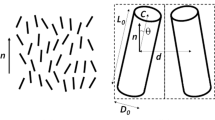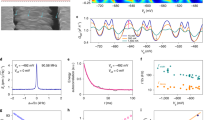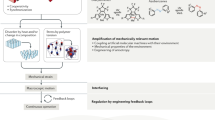Abstract
Analogues of mechanical devices that operate on the molecular level1,2,3,4,5, such as shuttles6,7,8,9,10, brakes11, ratchets12,13, turnstiles14 and unidirectional spinning motors15,16, are current targets of both synthetic chemistry and nanotechnology. These structures are designed to restrict the degrees of freedom of submolecular components such that they can only move with respect to each other in a predetermined manner, ideally under the influence of some external stimuli. Alternating-current (a.c.) electric fields are commonly used to probe electronic structure, but can also change the orientation of molecules17,18,19 (a phenomenon exploited in liquid crystal displays), or interact with large-scale molecular motions, such as the backbone fluctuations of semi-rigid polymers20,21. Here we show that modest a.c. fields can be used to monitor and influence the relative motion within certain rotaxanes22, molecules comprising a ring that rotates around a linear ‘thread’ carrying bulky ‘stoppers’ at each end. We observe strong birefringence at frequencies that correspond to the rate at which the molecular ring pirouettes about the thread, with the frequency of maximum birefringence, and by inference also the rate of ring pirouetting giving rise to it, changing as the electric field strength is varied. Computer simulations and nuclear magnetic resonance spectroscopy show the ring rotation to be the only dynamic process occurring on a timescale corresponding to the frequency of maximum birefringence, thus confirming that mechanical motion within the rotaxanes can be addressed, and to some extent controlled, by oscillating electric fields.
This is a preview of subscription content, access via your institution
Access options
Subscribe to this journal
Receive 51 print issues and online access
$199.00 per year
only $3.90 per issue
Buy this article
- Purchase on Springer Link
- Instant access to full article PDF
Prices may be subject to local taxes which are calculated during checkout




Similar content being viewed by others
References
Feynman, R. P. in Miniaturization (ed. Gilbert, H. D.) 282–296 (Reinhold, New York, 1961).
Mislow, K. Molecular machinery in organic chemistry. Chemtracts – Org. Chem. 2, 151–174 ( 1989).
Balzani, V., Gómez-López, M. & Stoddart, J. F. Molecular machines. Acc. Chem. Res. 31, 405–414 (1998).
Sauvage, J.-P. Transition metal-containing rotaxanes and catenanes in motion: toward molecular machines and motors. Acc. Chem. Res. 31, 611–619 (1998).
Gimzewski, J. Molecules, nanophysics and nanoelectronics. Phys. World 11, 29–33 (1998).
Anelli, P. -L., Spencer, N. & Stoddart, J. F. A molecular shuttle. J. Am. Chem. Soc. 113, 5131–5133 ( 1991).
Bissell, R. A., Córdova, E., Kaifer, A. E. & Stoddart, J. F. A chemically and electrochemically switchable molecular shuttle. Nature 369, 133–137 ( 1994).
Collin, J. -P., Gavinã, P. & Sauvage, J.-P. Electrochemically induced molecular motions in copper-complexed threaded systems: From the unstoppered compound to the semi-rotaxane and the fully blocked rotaxane. New J. Chem. 21, 525–528 (1996).
Lane, A. S., Leigh, D. A. & Murphy, A. Peptide-based molecular shuttles. J. Am. Chem. Soc. 119, 11092–11093 (1997).
Murakami, H., Kawabuchi, A., Kotoo, K., Kunitake, M. & Nakashima, N. A light-driven molecular shuttle based on a rotaxane. J. Am. Chem. Soc. 119, 7605– 7606 (1997).
Kelly, T. R. et al. A molecular brake. J. Am. Chem. Soc. 116, 3657–3658 (1994).
Kelly, T. R., Tellitu, I. & Sestelo, J. P. In search of molecular ratchets. Angew. Chem. Int. Edn Engl. 36, 1866–1868 (1997).
Davis, A. P. Tilting at windmills? The second law survives. Angew. Chem. Int. Edn Engl. 37, 909–910 ( 1998).
Bedard, T. C. & Moore, J. S. Design and synthesis of a “molecular turnstile”. J. Am. Chem. Soc. 117, 10662–10671 (1995).
Kelly, T. R., De Silva, H. & Silva, R. A. Unidirectional rotary motion in a molecular system. Nature 401, 150–152 (1999).
Koumura, N., Zijlstra, R. W. J., van Delden, R. A., Harada, N. & Feringa, B. L. Light-driven monodirectional molecular rotor. Nature 401, 152– 155 (1999).
Barthel, J., Bachhuber, K., Buchner, R. & Hetzenauer, H. Dielectric spectra of some common solvents in the microwave region - water and lower alcohols. Chem. Phys. Lett. 165, 369–373 (1990).
Castner, E. W., Chang, Y. J., Chu, Y. C. & Walrafen, G. E. The intermolecular dynamics of liquid water. J. Chem. Phys. 102, 653–659 (1995).
Cook, D. J., Chen, J. X., Morlino, E. A. & Hochstrasser, R. M. Terahertz-field-induced second-harmonic generation measurements of liquid dynamics. Chem. Phys. Lett. 309, 221– 228 (1999).
Kapitulnik, A., Casalnuovo, S., Lim, K. C. & Heeger, A. J. Electric-field coupling to slow elastic modes in gels of conjugated polymers. Phys. Rev. Lett. 53, 469– 472 (1984).
Lim, K. C., Kapitulnik, A., Zacher, R. & Heeger, A. J. Conformation of polydiacetylene macromolecules in solution: Field-induced birefringence and rotational diffusion constant. J. Chem. Phys. 82, 516–521 ( 1985).
Sauvage, J. -P. & Dietrich-Buchecker, C. O. (eds) Molecular Catenanes, Rotaxanes and Knots (Wiley-VCH, Weiheim, 1999).
Leigh, D. A., Murphy, A., Smart, J. P. & Slawin, A. M. Z. Glycylglycine rotaxanes – the hydrogen bond directed assembly of synthetic peptide rotaxanes. Angew. Chem. Int. Edn Engl. 36, 728–732 (1997).
Kippelen, B., Sandalphon, Meerholz, K. & Peyghambarian, N. Birefringence, Pockels, and Kerr effects in photorefractive polymers. Appl. Phys. Lett. 68, 1748–1750 ( 1996).
Buckingham, A. D. in Molecular Electro-optics (ed. O'Konski, C. T.) 7– 62 (Marcel Dekker, New York, 1976).
Sandström, J. Dynamic NMR Spectroscopy (Academic, London, 1982).
Dahlquist, F. W., Longmur, K. J. & Du Vernet, R. B. Direct observation of chemical exchange by a selective pulse NMR technique. J. Magn. Reson. 17, 406–410 (1975).
Leigh, D. A., Murphy, A., Smart, J. P., Deleuze, M. S. & Zerbetto, F. Controlling the frequency of macrocyclic ring rotation in benzylic amide [2]catenanes. J. Am. Chem. Soc. 120 , 6458–6467 (1998).
Allinger, N. L., Yuh, Y. H. & Lii, J.-H. Molecular mechanics. The MM3 force field for hydrocarbons. 1. J. Am. Chem. Soc. 111, 8551– 8582 (1989).
Ponder, J. W. & Richards, F. M. An efficient Newton-like method for molecular mechanics energy minimization of large molecules. J. Comp. Chem. 8, 1016–1024 (1987).
Acknowledgements
We thank L Joubert for his assistance in producing the visual representations of the rotaxane dynamics. This work was supported through the DRUM TMR network. F.Z. acknowledges support from the MURST project “Dispositivi Supramolecolari”. D.A.L. is an EPSRC Advanced Research Fellow; F.G.G. is a Marie Curie Research Fellow. The Warwick group were responsible for the synthesis and NMR experiments, the Bologna group the simulations, and the Paris group the Kerr effect measurements.
Author information
Authors and Affiliations
Corresponding author
Rights and permissions
About this article
Cite this article
Bermudez, V., Capron, N., Gase, T. et al. Influencing intramolecular motion with an alternating electric field . Nature 406, 608–611 (2000). https://doi.org/10.1038/35020531
Received:
Accepted:
Issue Date:
DOI: https://doi.org/10.1038/35020531
This article is cited by
-
Brownian Photomotors Based on Organic Compounds: A Review
Theoretical and Experimental Chemistry (2022)
-
A multistage rotational speed changing molecular rotor regulated by pH and metal cations
Nature Communications (2018)
-
Harvesting dissipated energy with a mesoscopic ratchet
Nature Communications (2015)
-
Magnetic quantum ratchet effect in graphene
Nature Nanotechnology (2013)
-
Molecular brake systems controlled by light and heat
Journal of Inclusion Phenomena and Macrocyclic Chemistry (2010)
Comments
By submitting a comment you agree to abide by our Terms and Community Guidelines. If you find something abusive or that does not comply with our terms or guidelines please flag it as inappropriate.



